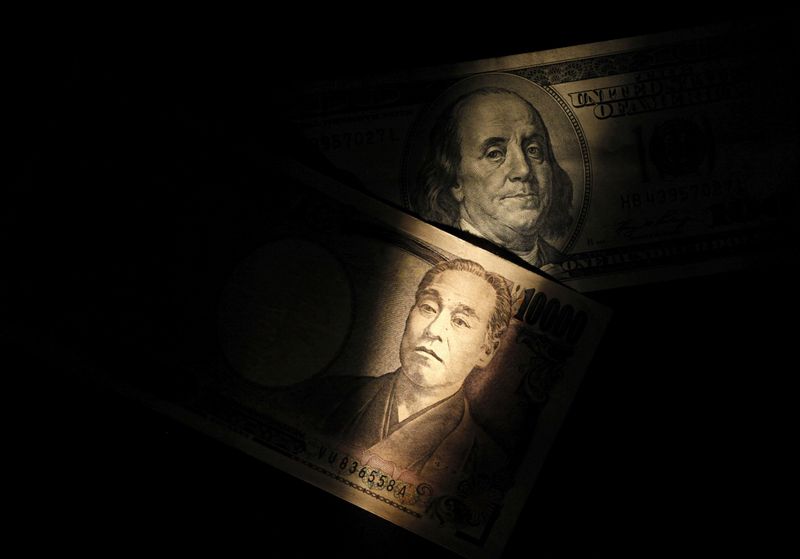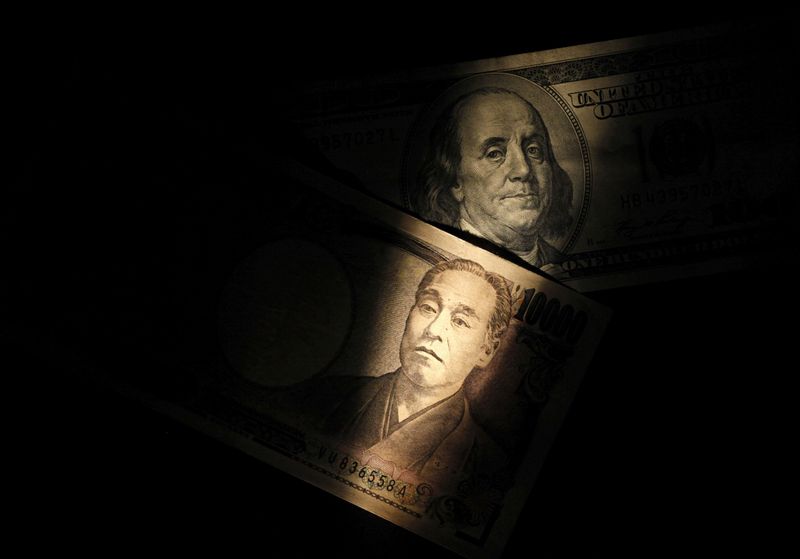Forex
Explainer-What would Japanese intervention to boost the weak yen look like?


© Reuters. FILE PHOTO: Light is cast on a U.S. one-hundred dollar bill next to a Japanese 10,000 yen note in this picture illustration shot February 28, 2013. REUTERS/Shohei Miyano/Illustration/File Photo
By Leika Kihara
TOKYO (Reuters) – Japanese authorities are facing renewed pressure to combat a sustained depreciation in the yen, as investors eye prospects of higher-for-longer U.S. interest rates while the Bank of Japan remains wedded to its super low interest rate policy.
Aside from verbal intervention, Japan’s government has several options to stem what it considers excessive yen falls. Among them is to intervene directly in the currency market, buying large amounts of yen, usually selling dollars for the Japanese currency.
Below are details on how yen-buying intervention could work, the likelihood of this happening and challenges of such a move:
LAST YEN-BUYING INTERVENTION?
Japan bought yen in September, its first foray in the market to boost its currency since 1998, after a Bank of Japan (BOJ) decision to maintain an ultra-loose monetary policy drove the yen as low as 145 per dollar. It intervened again in October after the yen plunged to a 32-year low of 151.94.
WHY STEP IN?
Yen-buying intervention is rare. Far more often the Ministry of Finance has sold yen to prevent its rise from hurting the export-reliant economy by making Japanese goods less competitive overseas.
But yen weakness is now seen as problematic, with Japanese firms having shifted production overseas and the economy heavily reliant on imports for goods ranging from fuel and raw materials to machinery parts.
WHAT HAPPENS FIRST?
When Japanese authorities escalate their verbal warnings to say they “stand ready to act decisively” against speculative moves, that is a sign intervention may be imminent.
Rate checking by the BOJ, when central bank officials call dealers and ask for buying or selling rates for the yen, is seen by traders as a possible precursor to intervention.
Finance Minister Shunichi Suzuki has recently said authorities “won’t rule out any options” to deal with excessive currency volatility, and that they were watching currency moves with a “strong sense of urgency.”
LINE IN THE SAND?
Authorities say they look at the speed of yen falls, rather than levels, and whether the moves are driven by speculators, to determine whether to step into the currency market.
The dollar is already within striking distance of the 150-yen level seen by markets as authorities’ line in the sand. If that line breaks, many market players see 151.94 yen, where Japan last intervened, as the next threshold, then 155.
WHAT’S THE TRIGGER?
The decision is highly political. When public anger over the weak yen and a subsequent rise in the cost of living is high, that puts pressure on the administration to respond. This was the case when Tokyo intervened last year.
But while inflation remains above the BOJ’s 2% target, public pressure has declined as fuel and global commodity prices have fallen from last year’s peaks.
If the yen’s slide accelerates and draws the ire of media and public, the chance of intervention would rise again.
The decision would not be easy. Intervention is costly and could easily fail, given that even a large burst of yen buying would pale next to the $7.5 trillion that change hands daily in the foreign exchange market.
HOW WOULD IT WORK?
When Japan intervenes to stem yen rises, the Ministry of Finance issues short-term bills, raising yen it then sells to weaken the Japanese currency.
To support the yen, however, the authorities must tap Japan’s foreign reserves for dollars to sell for yen.
In either case, the finance minister issues the order to intervene, and the BOJ executes the order as the ministry’s agent.
CHALLENGES?
Yen-buying intervention is more difficult than yen-selling.
While Japan holds nearly $1.3 trillion in foreign reserves, which could be substantially eroded if Tokyo intervened heavily repeatedly, leavuing authorities constrained over how long they can defend the yen.
Japanese authorities also consider it important to seek the support of Group of Seven partners, notably the United States if the intervention involves the dollar.
Washington gave tacit approval when Japan intervened last year, reflecting recent close bilateral relations. U.S. Treasury Secretary Janet Yellen said last month that whether Washington would show understanding over another yen-buying intervention by Japan “depends on the details” of the situation.

 Forex3 years ago
Forex3 years agoForex Today: the dollar is gaining strength amid gloomy sentiment at the start of the Fed’s week

 Forex3 years ago
Forex3 years agoUnbiased review of Pocket Option broker

 Forex3 years ago
Forex3 years agoDollar to pound sterling exchange rate today: Pound plummeted to its lowest since 1985

 Forex3 years ago
Forex3 years agoHow is the Australian dollar doing today?

 Cryptocurrency3 years ago
Cryptocurrency3 years agoWhat happened in the crypto market – current events today

 World3 years ago
World3 years agoWhy are modern video games an art form?

 Commodities3 years ago
Commodities3 years agoCopper continues to fall in price on expectations of lower demand in China

 Economy3 years ago
Economy3 years agoCrude oil tankers double in price due to EU anti-Russian sanctions























